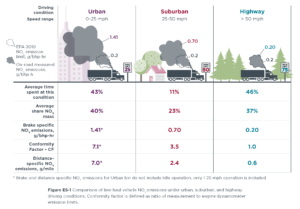A new ICTT report assesses the real-world nitrogen oxide (NOx) emissions behavior of heavy-duty diesel vehicles in the United States measured using portable emissions measurement systems (PEMS). This assessment is based on 160 PEMS tests from engines certified to 0.2 grams per brake horsepower-hour (g/bhp-hr) of NOx. The tests include data from eight manufacturers and 26 unique engine families certified between 2010 and 2016. Second-by-second data was analyzed to compare against the compliance evaluation results and to assess the impact of vehicle speed, vehicle type, and manufacturer on real-world NOx emissions.
A single line-haul truck emits the NOx equivalent of 100 cars for each mile driven in urban driving. Under urban driving conditions
The Not-to-Exceed (NTE) protocol evaluates less than 10% of the total emissions data to determine compliance for heavy-duty in-use NOx emissions. The average emission value of 0.18 g/bhp-hr obtained from the NTE evaluation is significantly lower than the value of 0.42 g/bhp-hr obtained when evaluated on a total route basis.
A disproportionate amount of NOx emissions from heavy-duty vehicles is emitted during the low-speed operation characteristic of urban driving. Vehicle operation at speeds of less than 25 mph results in NOx emissions of more than five times the certification limit for the average heavy-duty vehicle in the study.
At mid-speed driving conditions, between 25 and 50 mph and characteristic of suburban driving, average NOx emissions from heavy-duty vehicles (HDVs) are 2.7 times the certification limit. Only at highway speeds, above 50 mph, do HDVs present average NOx emissions at the certification limit and below the in-use NTE emissions limit of 0.3 g/bhp-hr.
Source: ICCT

